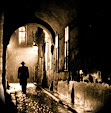
Just caught up with Johnny Depp and Michael Mann’s latest,
Public Enemies, which very well might be one of the most cursory period piece/biopics I’ve ever seen. For a film based on such a revered and well-researched book (Bryan Burroughs’
Public Enemies: America’s Greatest Crime Wave and the Birth of the FBI, 1933-34),
Public Enemies chooses to gloss over nearly all of the details of what made its subjects tick, to the point that they might as well be cardboard cutouts wearing trench coats and fedoras. We get to know nothing about John Dillinger, who is supposed to be flamboyant and larger-than-life, but whom Johnny Depp can’t help but make just a touch too dark and brooding. This is all summed up in a scene early on where Dillinger meets Marion Cotillard’s character Billie Frechette (who, by the way, is the only actor in the film who succeeds in seeming like a real person), and immediately tries to get her to run away with him. When she protests that she knows nothing about him, he responds “I like baseball, movies, good clothes, fast cars, whiskey, and you... what more do you need to know?” It’s a good line, and would probably be enough to get any woman to drop everything and take off with Johnny Depp. But Mann seems to think that this is all we as an audience need to know, as well, and for the remainder of the film that throwaway line will stand in for character development.
This is even more egregious in the case of Melvin Purvis, the FBI agent on Dillinger’s trail, who’s played by everyone’s favorite stoic Christian Bale, who is so wooden here that you get the impression he was placed into each scene by stagehands along with all the other props. Depp has enough inherent charm and personality that he’s always able to inject a little life into an underwritten character, but Bale, who seems to have a congenital inability to emote (
at least not at anyone other than his DP), is the last guy you want in that situation. We know his character is an FBI agent, and we know he wants to catch John Dillinger, but beyond that he’s a total enigma. God knows I’m not asking for the requisite domestic dispute scene where his wife, baby in hand, says something like “this case has made you a ghost in this house” (which, come to think of it, might be a line from Mann’s much better film
Heat), but a little flair or personality somewhere would have been nice.
Mann’s not helping the cause stylistically, either. You would hope that he might add to the dramatic depth of the story visually, as he’s proven he can do in the past, but he insists on shooting
Public Enemies (which takes place in the
dust bowl!) in a jittery, handheld, and distractingly digital style. I’ve seen few movies where the lack of film texture and grain is so obvious--and so clearly missed. I'm in no way one of those people who thinks that digital video is the scourge of modern cinema. But even the high dollar HD cameras like the one Mann used are still not at the level they should be. There are still things that the traditional film format does better, and I cannot imagine a setting that is more anathema to being shot in digital video than 1930s Chicago. Everything looks too slick and hyper-real, especially considering that the settings could have looked downright sumptuous if the filmmakers has shot them in the right way.
This antiseptic style carries over into nearly every other aspect of the film, including the ways in which it tries to build dramatic momentum. The film is based on one of those sweeping non-fiction epics, and watching it, it seems like its origins are always far too apparent. It’s as though every scene is a reenactment of something that is described in a much greater and more perceptive way in Burroughs’ book. It plays like a documentary without the narration, to the point that even when the scenes are slick and well-executed, you keep waiting for Peter Coyote (is there a more ubiquitous V.O. actor out there right now?) to start talking over the action to fill in the historical details.
I’ll close by saying that, all other faults aside, Michael Mann’s feel for action is as good as it’s ever been. The bank robbery in
Heat, and the ensuing gunfight in the streets, remains for me one of the most heart-pounding and tense action scenes ever committed to film, and though Mann never reaches that level here, he comes awfully close. At different points in the movie, especially in a scene that features George “Baby Face” Nelson literally going out in a blaze of glory, he delivers exactly the kind of weirdly poetic visual grammar that made
Heat one of the most wonderfully operatic action films of the 90s.
Public Enemies might be a misfire, but seriously, is there a film director out there more adept than Michael Mann at capturing the sheer mayhem of automatic weapons being fired off? I don’t think so.





